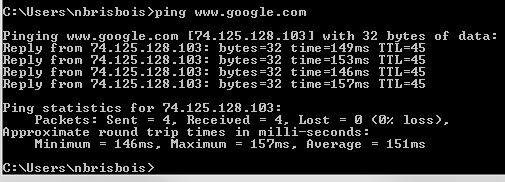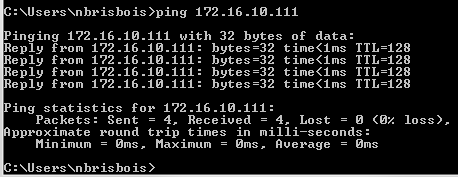The Url Format Is Not Correct the Correct Format Is Http 192 168 0 32 test txt Try Again
Pinging an IP address
This article explains how to ping an IP address for a device. The goal of pinging a device is to notice out if a device is reachable at a detail IP address.
Ping is a computer network administration utility used to test the reachability of a host on an Cyberspace Protocol (IP) network and to measure the round-trip time for letters sent from the originating host to a destination computer.
A device on a reckoner network should respond to a echo request (ping) with an repeat reply (pong) confirming it is online. This reply should come within milliseconds. If a answer does not come up information technology is said to have "timed out" considering the predefined await fourth dimension for a answer has been exceeded. If no reply is seen nosotros typically presume that no device is present at, or assigned with, that IP address.
Getting connected
For the purposes of this article we volition utilise a estimator running Windows 7. Other Microsoft operating systems since Windows XP will apply approximately the aforementioned procedure.
Connection is made via an Ethernet cable either directly between your computer's NIC and the Biamp device via a crossover cable, or via a network switch to a Biamp device on a network. Either connection type volition permit you lot to Ping the device's presumed address and run across if a device responds from that location.
cmd.exe
Begin by going to the Windows get-go menu.

Type the letters "cmd" into the Search box and hit Enter.

This will ask the Windows OS to run cmd.exe, commonly referred to as the "Command Prompt" interface. The following window should open on your desktop.
Ping
The Command Prompt allows various commands and queries to be sent to the system. For a Biamp device with the default IP address you will use the command " ping 192.168.1.101 ". If the device is at a dissimilar IP address, replace 192.168.1.101 with the address you lot are trying to poll.
After yous hitting Enter the request volition be sent 4 times, generating either a time out failure or a reply with round trip statistics.
To effort again, hit the Upwards pointer cardinal once to refresh the last command, and then Enter.
Failures tin present in a few ways, hither is what yous might expect to see back:
Two Ping failures are shown with slightly unlike feedback just no response from the intended device.
Check the cabling, ensure the physical path to the device is sound, and attempt again.
Success!
4 responses with skilful, quick response times.
Continuous ping
Use the command " ping 192.168.1.101 -t " to initiate a continuous ping. Again, replace the IP accost with i specific to your device equally needed. The -t can exist placed before or after the IP address.
Interrupt the pings with Ctrl-Break to see statistics on the captures.
Stop the pings with Ctrl-C.
" ping –t 192.168.1.101 >PingLog.txt " volition output the ping results to a txt file called "PingLog.txt", it volition not prove a scrolling trace in the cmd prompt window. It will be placed in the C:\Users\username directory. Change the file name so each is unique. Pings will happen in one case a second. command-C will terminate the ping and close the file.
Things you can ping
Ping is not limited to nearby hardware, you can too ping websites.

A ping to google.com
Or ping your own NIC.

Notation that the maximum circular trip fourth dimension for your own NIC is typically about 0ms.
Ping a range of IP addresses
In some situations you demand to ping a device but don't know where it lies inside the subnet range. This method can aid narrow downward the list of addresses beingness used.
In Windows, open the control prompt (Windows beginning menu > Search > type "cmd")
Fast ping fourth dimension
From the control prompt, type....
for /l %i in (1,1,254) do @ping 192.168.1.%i -westward x -n 1 | detect "Reply"
This will ping all addresses from 192.168.1.1 to 192.168.1.254 1 time each, wait 10ms for a reply (more than enough time on a local network) and testify only the addresses that replied.
Variables:
- Modify the IP accost afterwards @ping to reflect your network's IP range.
- Syntax for for /l is (outset,step,end) if yous want to alter the range to scan.
- The -w 10 tells it to simply expect 10 ms for a answer before moving on. If your network is irksome you lot volition have to increase this value or accept it out all together, although this will make it very irksome.
- The vertical line grapheme earlier find is typed as shift-\ on the Windows keyboard.
Also, note that the Windows detect is case sensitive, so make sure you capitalize "Reply" or y'all won't go any output. Optionally you tin can but type "eply" and it will automatically add the upper-case letter R in the response.
Longer ping fourth dimension
This is the same as higher up, with the -west variable changed to allow a 100ms reply window.
for /l %i in (1,i,254) do @ping 192.168.1.%i -westward 100 -due north i | notice "Reply"
This will ping all addresses from 192.168.i.1 to 192.168.1.254 one time each, wait 100ms for a reply and show but the addresses that replied.
Ping from a specific NIC
To specify the source interface to use, use the -s option. (You use the interface number, not the IP address). To identify the NIC interface number use the command " netsh int ipv4 testify interfaces "
To strength IPv4 or IPv6, use -4 or -half dozen.
To ping 192.168.0.ane using ipv4 from interface one, use the command " ping -4 192.168.0.1 -south 1 "
Ping to test MTU size
A standard ping packet is 32 bytes. The ping command supports a length (-50, lowercase L) aspect which allows you to define the ping parcel size. This allows you to test the maximum packet size you lot can send between 2 devices. The -f aspect sets a Don't Fragment (DF) flag in the packet (IPv4-only) which keeps the package size intact.
Multiple small TCP packets may exist aggregated past a switch to optimize transmission speed and latency. If the accumulation switch builds a package of 1500 bytes and the transmission path has another switch which but allows a maximum of 1492 bytes the package will be lost en route, as it will not be able to pass the restriction. The lowest MTU (maximum transmission unit of measurement) seen on a path volition be the brake. All switches on a path should permit the same MTU size.
A ping packet contains some overhead information, xx bytes are reserved for the IP header and 8 bytes are allocated to the ICMP Echo Request header. Add these 28 bytes to the length value you specify to get the full bundle size. E.thousand. For a total packet size of 1500 bytes you would subtract 28 bytes from 1500 for a length of 1472
" ping 192.168.0.1 -f -l 1472 "
Success looks like a standard ping response, failure yields the message " Bundle needs to exist fragmented simply DF ready."
C:\WINDOWS\System32>ping 192.168.0.1 -f -fifty 1472
Pinging 192.168.0.ane with 1472 bytes of data:
Reply from 192.168.0.1: bytes=1472 time<1ms TTL=64
Reply from 192.168.0.1: bytes=1472 time=1ms TTL=64
Reply from 192.168.0.i: bytes=1472 time=5ms TTL=64
Answer from 192.168.0.ane: bytes=1472 time=1ms TTL=64
Ping statistics for 192.168.0.ane:
Packets: Sent = 4, Received = four, Lost = 0 (0% loss),
Judge circular trip times in milli-seconds:
Minimum = 0ms, Maximum = 5ms, Average = 1ms
C:\WINDOWS\System32>ping 192.168.0.i -f -l 1550
Pinging 192.168.0.1 with 1550 bytes of information:
Packet needs to be fragmented but DF fix.
Parcel needs to be fragmented simply DF set up.
Packet needs to exist fragmented only DF set.
Parcel needs to be fragmented merely DF set up.
Ping statistics for 192.168.0.ane:
Packets: Sent = 4, Received = 0, Lost = 4 (100% loss),
Pathping
The pathping command is a combination of ping and tracert using ICMP letters. It can exist a helpful tool for testing a routed path between devices.
" pathping 192.168.0.one "
ARP
To detect the MAC address of the device at a specific address you can transport the arp -a command followed by the IP address of the device.
Alternately, you can arp for all devices on the network using only the arp -a command.
PowerShell
Open PowerShell (in the Windows menu search bar type 'Powershell') and re-create / paste these commands with the advisable IP address for the device under test.
If lines paste in reverse gild using right-click information technology may exist necessary to enable paste using CTRL+V in the PowerShell properties Options tab.
Continuous Ping
You can employ Wndows PowerShell to create a continuous ping examination.
Ping.exe -t 192.168.i.101
You tin can utilize Wndows PowerShell to create a logged continuous ping test.
Ping.exe -t 192.168.i.101 | ForEach-Object {"{0} - {one}" -f (Get-Date),$_} | Tee-Object C:\Temp\ping-192-168-i-101.log -Append
The continuous ping will run until the PowerShell window is airtight. The log output will look like this (intermediate log data has been cut out)
12/22/2021 3:51:31 PM - Pinging 172.30.41.56 with 32 bytes of data:
12/22/2021 three:51:31 PM - Respond from 172.30.41.56: bytes=32 time<1ms TTL=64
12/22/2021 3:51:32 PM - Reply from 172.thirty.41.56: bytes=32 fourth dimension<1ms TTL=64
12/22/2021 3:51:33 PM - Answer from 172.30.41.56: bytes=32 time<1ms TTL=64
...
12/28/2021 11:05:04 AM - Reply from 172.xxx.41.56: bytes=32 fourth dimension=1ms TTL=64
12/28/2021 11:05:05 AM - Reply from 172.xxx.41.56: bytes=32 fourth dimension=1ms TTL=64
12/28/2021 11:05:06 AM - Reply from 172.30.41.56: bytes=32 time=1ms TTL=64
12/28/2021 eleven:05:07 AM - Reply from 172.30.41.56: bytes=32 time<1ms TTL=64
12/28/2021 11:05:07 AM -
12/28/2021 eleven:05:07 AM - Ping statistics for 172.30.41.56:
12/28/2021 eleven:05:07 AM - Packets: Sent = 498410, Received = 498410, Lost = 0 (0% loss),
12/28/2021 11:05:07 AM - Approximate circular trip times in milli-seconds:
12/28/2021 eleven:05:07 AM - Minimum = 0ms, Maximum = 124ms, Average = 0ms
Open TCP port test
You can practice a simple one time test of a port using the following command, exist sure to enable HTTPS in Tesira Device Maintenance's Network Settings if a "true" result is desired::
Exam-NetConnection -Port 443 -ComputerName 192.168.1.101 -InformationLevel Detailed | Format-List *
You can run an extended test of an open port using this control prepare. This example runs for 720 minutes (12 hours) testing the port using TCP one time a minute and logging success (true) or failure (false) with the engagement and time.
$timer = new-timespan -Minutes 720
$clock = [diagnostics.stopwatch]::StartNew()
while ($clock.elapsed -lt $timer){
$command=Test-NetConnection -Port 443 -ComputerName 192.168.1.101 -InformationLevel Tranquility | ForEach-Object {"{0} - {ane}" -f (Become-Appointment),$_} | Tee-Object C:\Temp\check-192-168-1-101-port-443.log -Append
cls
$command
beginning-slumber -seconds threescore
}
write-host "Timer finish"
The continuous port test will run until the timer expires or the PowerShell window is airtight. The log output will look like this (intermediate log data has been cut out)
12/28/2021 9:00:15 AM - True
12/28/2021 9:01:15 AM - Truthful
12/28/2021 9:02:15 AM - True
12/28/2021 ix:03:15 AM - True
12/28/2021 9:04:15 AM - True
12/28/2021 9:05:15 AM - True
12/28/2021 9:06:xv AM - True
12/28/2021 9:07:15 AM - Truthful
12/28/2021 9:08:15 AM - True
12/28/2021 9:09:15 AM - Truthful
12/28/2021 9:10:16 AM - True
A test for multiple open TCP ports on 1 or more devices can be run using the script beneath.
# Biamp Tesira port test
#
# Outputs a unique log file for each IP address saved in C:\Temp\PortTest-$Ipaddr.log
# To save i file per port per device edit the 2 appearances of C:\Temp\PortTest-$Ipaddr.log to C:\Temp\PortTest-$Ipaddr-$Port.log
# Output reports results evidence in real-time in Powershell window
# If a device/port fails to respond it volition delay the next exam as Exam-NetConnection retries the device
#
$Ports = 22,23,80,443,61451 #TCP ports to examination
# 22 SSH, 23 Telnet, 80 HTTP (open if HTTPS is activated), 443 HTTPS, 61451 Tesira discovery and communication
# for models that exercise non back up HTTP/HTTPS ports 80 and 443 tin can be omitted
#
$Ipaddrs = '172.30.41.l', '172.thirty.41.53', '172.30.41.54' # IP addresses to test
#
$timer = new-timespan -Minutes 10 # test duration
# Duration of test in minutes 240 = 4 hrs, 480 = 8 hrs, 720 = 12 hrs, 960 = 16hrs, 1200 = 20 hrs, 1440 = 24 hrs, 2880 = 48 hrs, 4320 = 72 hrs
#
$clock = [diagnostics.stopwatch]::StartNew()
Foreach ($Ipaddr in $Ipaddrs){ # open welcome bulletin
"Begin $timer test period for $Ipaddr ports $ports"| ForEach-Object {"{0} - {1}" -f (Get-Date),$_} | Tee-Object C:\Temp\PortTest-$Ipaddr.log -Append
} # close welcome message
while ($clock.elapsed -lt $timer)
{ # open test period
$elapsed = $clock.elapsed
$sofar = $elapsed.ToString("hh' hrs 'mm' min 'ss' sec'")
$i++
#
Foreach ($Ipaddr in $Ipaddrs){
"Test period elapsed fourth dimension $sofar for $IPAddr. Test wheel $i" | ForEach-Object {"{0} - {1}" -f (Get-Date),$_} | Tee-Object C:\Temp\PortTest-$Ipaddr.log -Append # notes how long test has run and so far
Foreach ($Port in $Ports){
$portelapsed = $clock.elapsed
$portsofar = $portelapsed.ToString("hh'h'mm'grand'ss\.ff'south'")
if
(Test-NetConnection -ComputerName $Ipaddr -Port $Port -InformationLevel Quiet -WarningAction SilentlyContinue)
{"Pass $Ipaddr Port $Port is Open up at elapsed fourth dimension $portsofar"| ForEach-Object {"{0} - {1}" -f (Get-Date),$_} | Tee-Object C:\Temp\PortTest-$Ipaddr.log -Append}
else
{"---- $Ipaddr Port $Port is UNREACHABLE at elapsed time $portsofar" | ForEach-Object {"{0} - {i}" -f (Get-Engagement),$_} | Tee-Object C:\Temp\PortTest-$Ipaddr.log -Append}
}
}
get-go-sleep -seconds 60 #Fourth dimension to expect between port scan tests
} # close test period
Foreach ($Ipaddr in $Ipaddrs){ # open completed test message
"Examination menstruation duration $timer is complete for $Ipaddr subsequently $i tests"| ForEach-Object {"{0} - {1}" -f (Get-Date),$_} | Tee-Object C:\Temp\PortTest-$Ipaddr.log -Append
} # close completed exam message
$i = 0 # reset count
write-host "All tests completed." # completed test message, for concluding only
Trace route
Trace road or trace road with hop latency. The -Hops variable limits how many hops are shown.
Test-NetConnection 172.30.41.50 -traceRoute
or
Examination-NetConnection 172.30.41.50 -traceRoute -Hops ten | select-object TraceRoute | foreach-object {test-connection $_.TraceRoute -count 1}
Source: https://support.biamp.com/General/Networking/Pinging_an_IP_address
0 Response to "The Url Format Is Not Correct the Correct Format Is Http 192 168 0 32 test txt Try Again"
Postar um comentário